Special Feature: Products Sally Recommends
Necessary Cookware
Blaming lousy cooking results on lousy cookware happens to be a valid excuse. If you are just beginning to acquire the pots, pans, and tools that see you through even the most rudimentary recipes, stop now to consider the details.
-
Do you think that nonstick cookware will save you from ruination?
-
Do you think that buying a set of cookware will get you off to a good start?
-
Do you want to serve directly from the pan you cook in?
-
Do you have any idea what you like to cook (and eat) so a cookware clerk can lead you to the right equipment?
-
Do you want your cookware to last forever? (Hint: the right stuff certainly will.)
"You wouldn't use old rusty tools on your car," says Clinton Peters, a 30-something cookware specialist at William Glen, a fine housewares store in Sacramento, California. "Why would cheap, flimsy cookware help you fix food?" His edicts are simple. Everyone needs one or two nonstick pans for omelets, the occasional chop and grilled cheese sandwiches. Everyone needs one or two of those "forever" pans -- the big-ticket items. The rest is filler.
Nonstick pans give the illusion that your food is safe. It isn't. If lined inside a light hollow pan, it's anyone's guess where heat will end up. As you progress in your cooking, you will discover that sticking is actually a desirable event. The foresight needed to make sauce from pan drippings begs a few stuck-on particles of turkey or roast, "or you can screw yourself out of some great tasting pan scrapings," Peters says. Needless nonstick cookware is another waste. A nonstick surface inside a stock pot whose chief contents will be boiling liquid is like driving an armored car through a pile of feathers. So, what to buy? "I'm a big label freak," Peters says. "In most cases, you do get what you pay for." The brands he swears by are Le Creuset and All-Clad. The gray matter -- Calphalon -- is a moderate choice but unless it's lined with shiny stainless steel, it's dark and hard to see what is happening with the food.
One of the reasons to spend extra is to get the most control over your pans, or your pans will control you.
A wide, heavy skillet with a matching lid is used endlessly for a rather worn cooking process that is all over the place as far as heat variation in a single recipe. In this pan you can saute chicken over high heat, add liquid, reduce the heat, cover the skillet and begin a reliable period of braising until the chicken's done. During the first stage, the chicken will stick a little and leave behind bits on the bottom of the pan. When the liquid goes in (chicken stock, water, wine) the stuck-on parts will dissolve and flavor and color the resulting sauce. This isn't the magic that nonstick surfaces trade in.
When customers complain about the price and weight of Le Creuset or All-Clad, particular for the wide, heavy skillet described above, Peters suggests that you use two potholdered hands to lift it, and be prepared to have it forever.
"Good cookware is heavy because of the way it's constructed," Peters says. "The lighter and thinner the pan, the more control over it you lose." A light hollow pan might have a chaotic way of dispersing heat. Sometimes the heat goes crazy in a few areas, making hot spots (where scorching occurs). Sometimes the heat just stays on the bottom and refuses to move up the sides because the material simply blocks its passage. "Nothing beats heavy cookware for low-temperature slow cooking," Peters says.
That leaves us with this starter set, which isn't a set but a collection of sound choices:
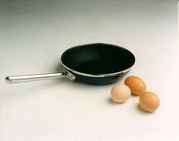 1. Wide, heavy skillet with matching lid
1. Wide, heavy skillet with matching lid
Look
for a 12-inch diameter (or bigger) and thick material in a pan that's at least
2 inches deep. This pan may have one long handle, or two loop handles on either
side. Find it by homing in on terms such as buffet casserole, paella pan shapes,
international skillet, all-around pan, or everyday pan. A slightly domed lid is
good for covering chicken or piles of leafy greens that start out big but get
small when they're done. Beginners and experienced cooks love clear lids so we
can all see what's going on inside the covered pan. Beware of plastic knobs and
handles. You'll be happier if all the parts can go in the oven, a not-so-unusual
happenstance for brainless braising after an initial saute.
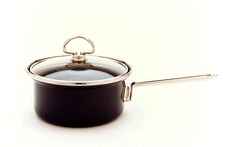 2. A heavy,
thick saucepan (a.k.a. pot).
2. A heavy,
thick saucepan (a.k.a. pot).
Here
is the pot for boiling potatoes, cooking all sorts of vegetables and making small
batches of soup or big batches of gravy. Start with a 2- or 3-quart, with thick
material and a good fitting lid.
3. A dutch oven
This is the
pot you'll use for making chili, stew, or soup, or for boiling pasta. They're
about 3 1/2 to 6 quarts with loop handles on either side. Sometimes they're called
a French oven. The reason the term "oven" is used is because they once
acted as ovens -- heat retainers -- with hot coals top and bottom. New shapes
and terms are replacing the Dutch oven of old, and you might consider items variously
called "chef's pan" with more rounded sides, or "sauce" pots
at about 3 1/2 quarts.
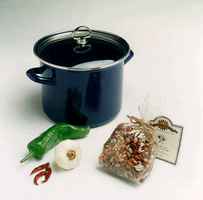 4. A stock pot
4. A stock pot
A
stock pot always is taller than it is wide. It's for making stocks out of whole
chickens or roasted beef bones. It's also a good pot for boiling pasta; many come
with a pasta insert easy to withdraw after the pasta's done so you don't have
to carry a vat of hot water over to the sink where your colander lies in wait.
A nonstick lining is as useless in a stock pot as an expensive rendition in copper.
All you need is a sturdy stainless steel boiling pot, which will be a modestly
priced lifetime buy. Look for 8- to 12-quarts sizes. Avoid plain aluminum. I used
an aluminum stock pot for 20 years before I switched to stainless steel, but I've
forgotten why. (Oh yes, the Alzheimer's connection.)
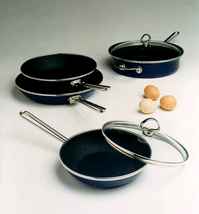 5. Two non-stick
omelet pans
5. Two non-stick
omelet pans
Get
a 6-inch and an 8- or 10-inch. Buy brands with some weight and a thickly designed
exterior. This pan almost always will go over high heat, and it's got to be able
to take it. You'll use this for all sorts of eggs, grilled cheese and quesadillas,
things that stick when you truly wish they wouldn't and are a mess to clean up.
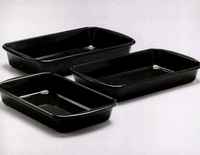 6. A roasting pan
6. A roasting pan
Buy
one that can go from stove to oven and back again -- no glass, no ceramic. Many
times after you've roasted the chicken, the pan drippings (which hopefully have
stuck) go back to the stove for the additions of wine or stock to make sauce or
gravy. If you roast in glass, what's left in it will have to be transferred to
another pot. Not only do you lose pan juices in the transition, you've got another
pot to wash. A reasonable dimension for a roasting pan is 9x13 inches with sides
about 1 1/2 inches high.
![]()
Elaine Corn is a Sacramento-based freelance writer and cooking teacher as well as the author of two books, Now You're Cooking for Company and Now You're Cooking
Note: This information was accurate when it was published. Please be sure to confirm all rates and details directly with the businesses in question before making your plans.



